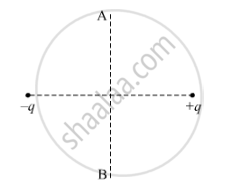Advertisements
Advertisements
प्रश्न
The magnetic moment vectors µs and µl associated with the intrinsic spin angular momentum S and orbital angular momentum l, respectively, of an electron are predicted by quantum theory (and verified experimentally to a high accuracy) to be given by:
µs = –(e/m) S,
µl = –(e/2m) l
Which of these relations is in accordance with the result expected classically? Outline the derivation of the classical result.
उत्तर
The magnetic moment associated with the orbital angular momentum is valid with classical mechanics.
The magnetic moment associated with the orbital angular momentum is given as
µl = `-("e"/(2"m")) "l"`
For current i and area of cross-section A, we have the relation:
Magnetic moment
µl = iA ……….(1)
Where,
e = Charge of the electron
r = Radius of the circular orbit
T = Time taken to complete one rotation around the circular orbit of radius r
Orbital angular momentum, l = mvr
L = `"m" xx (2π"r")/"T" xx "r"` ……….(2)
Where,
m = Mass of the electron
v = Velocity of the electron
r = Radius of the circular orbit
Dividing equation (1) by equation (2), we get:
`(µ_"l")/"T" = -("e"/(2"m"))`
µl = `-("e"/(2"m")) "l"`
APPEARS IN
संबंधित प्रश्न
A charge 'q' is moved from a point A above a dipole of dipole moment 'p' to a point B below the dipole in equatorial plane without acceleration. Find the work done in the process.

An electron in an atom revolves around the nucleus in an orbit of radius 0.53 Å. If the frequency of revolution of an electron is 9 x109 MHz, calculate the orbital angular momentum
[Given : Charge on an electron = 1.6 x 10–19 C; Gyromagnetic ratio = 8.8 x 1010 C/kg; π = 3.142]
Draw the diagrams showing the dipole moments in paramagnetic substance when external magnetic field is (a) absent (b) strong
Do two distinct poles actually exist at two nearby points in a magnetic dipole?
A circular loop carrying a current is replaced by an equivalent magnetic dipole. A point on the loop is in ______.
When a current in a circular loop is equivalently replaced by a magnetic dipole,
Let r be the distance of a point on the axis of a bar magnet from its centre. The magnetic field at such a point is proportional to
Let r be the distance of a point on the axis of a magnetic dipole from its centre. The magnetic field at such a point is proportional to
Pick the correct options.
(a) Magnetic field is produced by electric charges only
(b) Magnetic poles are only mathematical assumptions having no real existence
(b) A north pole is equivalent to a clockwise current and a south pole is equivalent to an anticlockwise current.
(d) A bar magnet is equivalent to a long, straight current.
